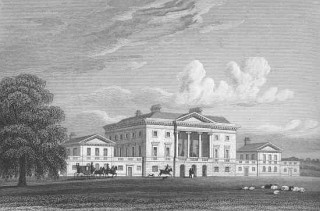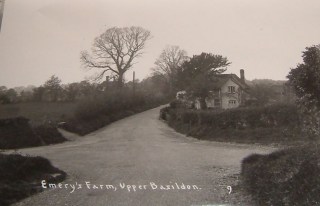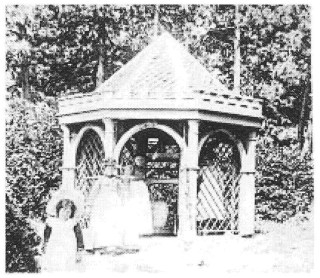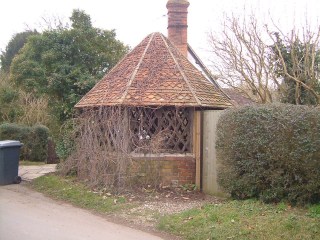A brief history of Basildon, Berkshire
By Clive Williams, OBE
Basildon is a Thames-side Parish in the Royal County of Berkshire, lying between Pangbourne to the south and Streatley to the north and some 8 miles west of Reading. It has a population of 1600 and comprises some 3,500 acres.
Nowadays it is best known for Basildon Park, a National Trust property, built by John Carr of York between 1777-1783 for Sir Francis Sykes, one of the East India nabobs. It has a history, often turbulent, that has been recorded back to Neolithic times. It was settled by the Romans and then became a royal Saxon Manor, suffering from Mercian and Viking attacks. It was sacked by Sweyn of Denmark in 1006 and was then sacked again by the Norman army, when they crossed the Thames at Streatley on their march to take London. The Domesday Book records the extent of the devastation.
Stephen and Matilda fought their war through Thames Valley in the 13thC and in the 14thC the Black Death wiped out all the tenants. In the 17thC the famous agriculturalist, Jethro Tull was born in the Parish and although he spent all his life away from Basildon, by his will he requested that he should be buried in Basildon and this is what happened.
 |
| Basildon Park in 1829 |
In the mid 17thC, the Fane family acquired the principal Manor of Basildon, then about 2,500 acres. Col George Fane had been a prominent Royalist Commander, who had been ruined by the Civil War. So his younger sister, Rachel, who had married the Earl of Bath stepped in and bought the Basildon estate for her brother. In the mid 18thC, Lady Fane, the wife of the first Viscount, built a famous Grotto after his death attached to a small house, which her husband built for her, close to the river Thames. Costing half a million in today’s money, it was as famous in its day as that of the Countess of Richmond and Alexander Pope. The House, now much enlarged, has always been known in consequence as ‘The Grotto’ but there is very little left of the actual Grotto.
The Fane Viscountcy died out in 1768 and in 1770 the Basildon estate was sold to Sir Francis Sykes. who died in 1804, only four months before his son the 2nd Baronet also died. That meant that his five year old grandson, Sir Francis William Sykes, inherited. He turned out to be a spend-thrift; squandered his grand-father’s fortune ,and by 1838 was forced to sell the estate. When his wife started an affair with the painter Daniel Maclise, Sir Francis disowned her and publicly humiliated her and Maclise. This was a mistake as Maclise’s best friend was Charles Dickens and Dickens was writing ‘Oliver Twist’. The villainous character Bill Sikes was Dickens’ revenge on Sir Francis.
 |
| Emery's Farm, Upper Basildon c.1910 |
In 1838 the estate was bought by James Morrison, a self-made man, of Scottish descent, who was the son of an inn-keeper at Middle Wallop, Hants. He had previously bought the estate of Fonthill in Wiltshire, which is still with the family, but with the arrival of the GWR in Berkshire in 1840, he found he could get to London from Pangbourne in an hour, whereas the journey from Fonthill took 10! When James Morrison died in 1857, he was worth 2.5million pounds, reputedly the wealthiest commoner in the UK. There are two amusing stories, illustrating his genius for making money . In one case he came to the view that the Queen was not looking that well and went out and bought all the black crepe he could lay his hands on and stockpiled it. When the Queen died not long after, the country went into official mourning for a week and black crepe was de rigueur. As one man owned virtually the entire stock, he could name his own price! In the other case he went on the grand tour of Italy and as kid skin gloves were the height of fashion, while there he hired a factory, bought all the kid skins he could and had manufactured 500,000 kid skin gloves. Then he shipped them to Southampton, where Customs handed him a very large import bill. He refused to pay and the consignment was confiscated. It then went to auction and Morrison bought the load at a knock-down price as he was the only bidder. A month later another consignment came in and the same thing happened. So he brought in his gloves without having to pay much in the way of duty. There was a reason but for that you will either have to work it out or to read my History of Basildon!
James Morrison also amassed a very fine collection of grandmasters. What survives of the collection is now located at Sudeley castle, Glos where his great- great, grandson and grand daughter live – Henry and Molly Dent-Brocklehurst.
 |
| The Well at The Well House, Bethesda St. c.1905 |
James Morrison’s eldest son, Charles inherited the estate and the island of Islay in the Inner Hebrides. Charles Morrison appears to have just two interests in life – high finance and architecture. He never married and when he died in 1909, at the ripe old age of 91, he left 10million pounds, about half a billion in today’s money. He also left approximately 15 new or modernized estate cottages, in 3 distinct building styles, and 2 Schools to serve the two communities of Upper and Lower Basildon.
By 1909, the Basildon estate had grown to include every farm and virtually every house in the Parish. In addition, first James and then Charles had bought land all round the former North Berkshire, particularly in Cholsey, where the same building style can be seen as in Upper Basildon.
In 1910, the Basildon estate and all the outlying land in North Berkshire was inherited by Major James Archibald Morrison, Charles’ nephew. He was a sportsman- he rowed in winning boats for Oxford and Leander and was an expert shot. It was as a result of a shooting party at Basildon Park in 1911 that the visiting directors from a printing company went home with the name ‘Basildon Bond’ for their new paper. He had distinguished himself in the Boer War and he had then been elected as a Conservative MP for Nottingham. He was a paternal, kindly individual, who clearly set out to use his great wealth to turn Basildon into a model estate. His very first act was to bring piped water to the Basildon estate, from a pumping station which he installed at another of his properties, Wood Farm, Streatley. He then built another pumping station in Beckfords, Upper Basildon, next to the school. This pumping station has been a residential property for over 30 years but. the Wood Farm pumping station now belongs to Thames Water and still serves the local area.
Whenever Major Morrison erected a building, he had installed two plaques, the first bearing his initials JAM and the second the date. We know as a result that during the period 1910-1914, he built 11 cottages or houses in Basildon and 4 in the adjoining Parish of Streatley. It is likely that 2 other substantial houses, which he also built, date from the time, but they could possibly be later.

|
| The Old Village Well at Smith's Corner in 2006 |
In 1914, Major Morrison went off to join his regiment, the Grenadier Guards. Harold Macmillan, then a Lieutenant, served under him and writes of him with affection and respect in his autobiography. At the Somme in 1916, he was severely wounded and had to be invalided out of the army, being awarded the DSO. Basildon Park was turned over to his Regiment to serve as a Guards’ convalescent home. The White House in Lower Basildon played a similar role for local men.
In 1917 he conceived the idea of building a memorial church for the fallen of the Parish, as part of a scheme, which would include a Vicarage, Graveyard, Almshouses, Communal Kitchen, Men’s Institute and School. Sir Edwin Lutyens was given the commission and prepared rough sketches, which are held by the Royal Institute of British Architects. The sketch for the church shows a very strong Indian influence, no doubt reflecting Sir Edwin’s time with the Delhi Planning Commission.
However in 1918 the scheme was abandoned. Sir Edwin’s personal diary entry for May 27th 1918 shows why. ‘Morrison says bring laundry down if you like to stay. Saturday night I won through with the communal idea. Sunday I lost it. Phillips and parson and self in a minority. Rural conditions difficult. The difficulties they have had in only semi-detached cottages with the women quarrelling they say makes the scheme impossible... ... ...
In 1929 Major Morrison sold the Basildon estate to his Yattendon neighbour, Sir Edwrd Mauger Iliffe (later the 1st Lord Iliffe) for £90,000 (about £16 an acre). Sir Edward then auctioned off most of Basildon parish and it ceased to be an estate village. George Samuel Ferdinando bought Basildon Park and initially tried to sell the Mansion, which by now was somewhat run-down. The contents of the Mansion were then sold – including the wall fittings and ceilings, which found their way to the Waldorf Astoria in New York, where they feature in ’The Basildon room’. Ferdinando then had a change of heart and kept and lived on the Mansion until the outbreak of war, when it was again requisitioned for military use. The British Army used it until 1943 and it was then made available to the 101st Airborne Division – the ‘Screaming Eagles’ – for the 81st A/B Anti-Aircraft battalion and a Battalion of 326 Engineers. The Colonel of the 81st A/B, Col XB Cox, lives in Texas and last visited Basildon in 2004 for the 60th Anniversary of the D-Day landings.
After the War the Mansion was de-requisitioned and handed back to the Ferdinando family. But it was by now in a ruinous state and too expensive for the Ferdinandos to restore. It faced demolition, a fate that overtook hundreds of large country houses in the 1950’s but then the 2nd Lord Iliffe and his wife Renee stepped in and bought the Mansion. Over the years they brought the Mansion back to life. The missing fittings were replaced by the contents of another Carr house, Panton Hall in Lincs, which was demolished. As Carr built all his houses to the same dimensions, the doors fitted perfectly. In 1977 Lord and Lady Iliffe donated the House and grounds to the National Trust, who have cared for it subsequently.
The full History of Basildon from pre-historic times to today is set out in the 2nd Edition of ‘Basildon, Berkshire- an Illustrated History’. This is available from the author, Clive Williams OBE at Honeycroft House, Pangbourne Road, Upper Basildon, Reading, Berks RG8 8LP. The book is hard-back and runs to 300 pages with 147 illustrations.
